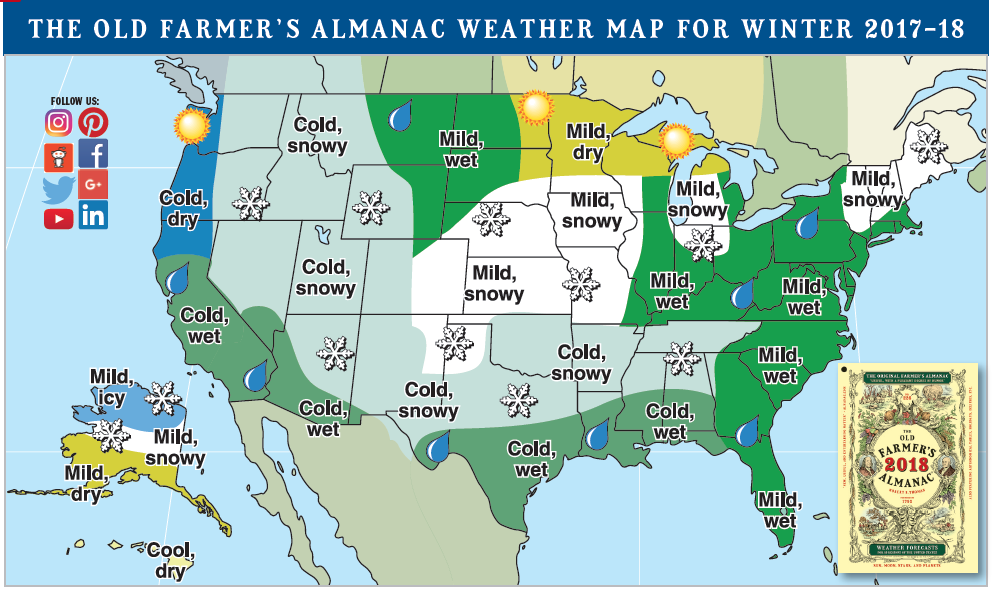
As a homeowner, your life would be immeasurably easier if you could predict what type of weather conditions are headed your way with each incoming winter season. You’d know what kind of precautions to take, whether to invest in certain equipment, and how to plan for your snow removal efforts.
Fortunately, it turns out you can get a window into the future. For over two hundred years, farmers, business people, families, and industry leaders have consulted the Old Farmer’s Almanac for accurate predictions of what type of weather to expect months ahead of time.
What is the Old Farmer’s Almanac?
If you were to Google “Farmer’s Almanac,” you’d come up with more than one resource with similar sounding names, but the publishers of The Old Farmer’s Almanac have always maintained that theirs is the true, original source. The difference between the Old Farmer’s Almanac and other almanacs is proudly discussed on the company’s website. The signature yellow cover distinguishes this almanac from other similar sources and remains a tradition with this publication since 1854.
Robert Bailey Thomas was the founder and first editor of the Old Farmer’s Almanac, which was created back in George Washington’s time. Founded in 1792, the book was sold for merely a six-pence (approximately nine cents) and could be bought in Boston bookstores and from traveling peddlers in the New England countryside.
Born out of Thomas’s fascination with astronomy, the book grew in popularity toward the beginning of the nineteenth century. In 1815, the book’s reputation temporarily suffered a setback when an inadvertent printer’s error resulted in snow being predicted for July and August. But interestingly, a volcanic eruption in the area now known as Indonesia lowered world temperatures several degrees. The volcanic ash resulted in “snow” in July and August, making the Almanac accurate after all.
Where Does the Almanac Get its Information?
The basis for the almanac’s information is a closely guarded secret. Publishers will only disclose that the predictions come from a special formula relying on solar science, climatology, and meteorology. Only a select number of people have access to this formula. The Almanac prides itself on being “useful, with a pleasant degree of humor,” enabling readers to prepare for and ultimately confront harsh conditions.
How Accurate is the Almanac?
While some meteorologists scoff at the Almanac’s claim of being able to predict weather patterns, the publishers are the first to admit when its predictions have gone awry. In 2012, it erroneously predicted heavy snow and freezing conditions, when in fact the climate was unusually warm.
On the other hand, the 2014-2015 predictions were highly accurate, warning of heavy snow on the East Coast as well as New England’s January Nor’easter. In 2014, the Almanac publicly estimated that its predictions are accurate 80 percent of the time.
What’s to Be Expected in the U.S. Winter 2017/18?
The colorful hard copy of the Old Farmer’s Almanac continues to sell every year, but the book’s website provides valuable free information about upcoming weather. The online Almanac divides the United States into eighteen distinct regions for easy reference:
- Northeast
- Atlantic Corridor
- Appalachians
- Southeast
- Florida
- Lower Lakes
- Ohio Valley
- Deep South
- Upper Midwest
- Heartland
- Texas-Oklahoma
- High Plains
- Intermountain
- Desert Southwest
- Pacific Northwest
- Pacific Southwest
- Alaska
- Hawaii
Intermountain
The Intermountain region is composed of sections of Washington, Oregon, Nevada, Idaho, Montana, Wyoming, Colorado, Utah, and Arizona.
The prediction for Winter 2017/18 in the United States is for colder than normal temperatures with above-normal snowfall in the northern and southern sections of the Intermountain region. The snowiest periods will be early and mid-to-late December, mid-January, early and mid-February, and early March.
Texas-Oklahoma
The Texas-Oklahoma region includes portions of those states along with sections of New Mexico. The Winter 2017/18 prediction from the Almanac calls for colder than normal temperatures with above-normal precipitation. Considering this region is in a southern part of the United States, homeowners might be caught unaware when higher than expected snowfall pelts areas that are normally considered mild.
Pacific Northwest
Parts of California, Oregon, and Washington make up the Pacific Northwest. Near to below normal snowfall is expected in the Winter 2017/18 season. While this is generally good news, the weather is expected to be colder than normal. This is significant, because even a light coating of snow can be dangerous if it is frozen solid, forming a sheet of ice on walkways.
Late November to early December as well as late December is predicted to be the coldest part of the year, and the snowiest period will be the month of December.
Heartland
The Heartland region of the United States consists of parts of Illinois, Iowa, Kansas, Missouri, Nebraska, South Dakota, and Wisconsin. For the Winter 2017/18 season, the Almanac predicts milder than normal conditions with above-normal precipitation and snowfall.
While the term “milder” is encouraging, it’s important to remember that heavy precipitation followed by warmer weather might lead to fast melting snow and thus, slushy, slippery conditions.
Forewarned is Forearmed: Preparing for the Winter 2017/18 Season
Once you’ve determined what type of winter to expect, you can plan ahead of time and keep weather-related disruption to a minimum. We wish you a safe winter.


